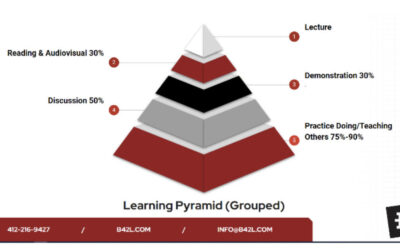Introduction:
In 2023 it is common practice to conduct Workplace Safety Training. Employers are finally recognizing that they have a responsibility to train their employees on the hazardous tasks/settings in their workplace. However, there are certainly ways to properly conduct safety training and methods that are not effective. We’ll discuss the most effective modes of Safety Training, and how you can effectively create/select the most effective safety training for your workplace.
Training is not Presenting
When asked if your workplace conducts safety training, on the surface that can be a simple yes or no question. When we take a step back and think about what training is, many employers are actually presenting and not actually training. What is the difference?
Training: The action of sharing information to develop skills. Training takes place with student involvement and activities. Training includes the elements below:
- Hands on practice of a specific skill
- Workshops used to teach students the mechanics of a subject
- Group discussion that stimulates the students thought process by sharing information from different experiences and points of view
- Visual aids such as props, demonstrations, and experiments
Presenting: Involves listening to information to learn a skill or understand a subject.
Presenting is conducted most often through lecture format as means to communicate specific information on desired subjects. B42L asks many of its partners/prospective partners “How do you conduct your safety training”. The most common responses we receive are found below:
- “We have monthly safety meetings where everyone comes together for a 30min-1hr lecture on a specific topic”
- “We have our employees watch safety training videos on a regular basis covering necessary topics we are required to cover per OSHA guidelines”
- “We conduct field safety discussions on topics that are relevant to our workplace”
What is the goal of Safety Training?
The primary goal of any safety training is to outline a specific task/hazard, and communicate how to accomplish the task safely while avoiding injury and incident.
The National Training Laboratories (Bethel, Maine) has conducted research on the modalities of learning and created a Learning Pyramid that shows student retention rates using different forms of training. Retention rates of learning are found in percentages below. *Note official Learning Pyramid can be found at https://www.ntl.org/.

What does your team think about your Safety Training?
This learning pyramid is far from an “end all be all” as it pertains to the effectiveness of your safety training. But it is an excellent starting point when you are evaluating if your training is effective or not.
Are your employees retaining the safety training you provide? How many times have you presented a topic, and 4 hours later you are observing someone engaged in the opposite of the desired behavior that was just discussed? Although working safely is heavily influenced by outside factors including time pressure, personal beliefs, and human behavior, it is important to understand that if employees are not produced with a convincing argument to work safe (effective safety training), they will choose the most convenient way to accomplish the task. Remember, just because it is convenient, does not make it safe.
After your training is defined, it is equally important to identify if it is effective or not. If you are performing the same training over and over again, and still suffering the same incidents, are you really accomplishing anything? Or are you simply checking the box for compliance?
What you can track, you can measure.
It is best practice to track the types of incidents your company incurs. Ask yourself the following questions when you review the incidents in your company:
- What work tasks are producing incidents?
- What level of training do the involved workers have?
- What kind of training have they been put through?
- Is my computer based safety training, or power point lectures effectively preventing reoccurring incidents?
- When was the last time we refreshed, updated, or enhanced our training?
- What could I do to enhance my safety training and make it more effective?
- Can I accomplish this by myself?
Being honest with yourself
Creating effective safety training is not an easy task. In 2017, The Association for Talent Development conducted a survey and found it takes on average 28 hours to develop a 1hr. Instructor Led Training. That study is found below.
https://www.td.org/insights/how-long-does-it-take-to-develop-one-hour-of-training-2017
Knowing that you do not have all the time and resources to constantly audit your safety training, and measure for its effectiveness, it is recommended you audit your entire safety training program on an annual basis, and aspects of it more often when there are incidents.
Audit and Enhance your Safety Training
B42L strives to construct well thought out, informative, and effective safety training to its partners. Remember, effective safety training is difficult to master and often times expensive.
Allow B42L to work with you to enhance your safety training program at a cost effective level. Our team has found simple yet effective ways to teach and train skills that stick.
For more information on all of B42L Safety Services, reach out to info@b42l.com or call 412-216-9427.





